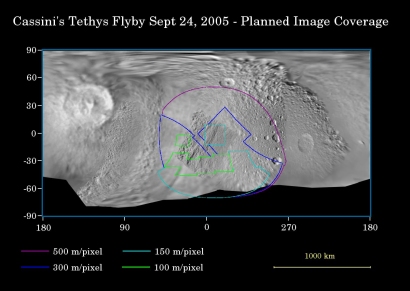Tethys Flyby - September 2005
23 September 2005
The Tethys flyby is technically non-targeted (meaning there are no manoeuvres solely designed to control the flyby trajectory); however, through efforts recently made by the Cassini navigation team, this encounter was able to be lowered to allow for a close study of the icy moon.This encounter is set up with two manoeuvres: an apoapsis manoeuvre on 19 September, and an approach manoeuvre, on 23 September.
The closest approach to Tethys occurs on Saturday, 24 September, at 02:42 UT at an altitude of 1500 km above the surface and at a speed of 9 kilometres per second. The flyby is outbound from Saturn, with periapsis occurring on 23 September. This is the fifth close encounter with Saturn's icy satellites, after Phoebe and three Enceladus encounters (in orbit 3, non-targeted; orbit 4 and orbit 11).
Science Activities
Key questions about Tethys that this encounter's activities hope to unlock include:
- What is Ithaca Chasma?
- How is it related to the large crater Odysseus?
- What are their relation to the history and formation of the body?
- What are the resurfacing dynamics of the satellite?
- What are the trace elements on the surface and how are they distributed?
- How does the E ring interact with Tethys, which lies deep inside it?
- Could Tethys be a partial source of the E ring?
This encounter should offer spectacular views of Ithaca Chasma.
- Composite Infrared Spectrometer (CIRS)
CIRS will make measurements to constrain the bolometric albedo, thermal inertial and volatile stability of Tethys, and obtain spectra in the 10-500 μm wavelength region to search for compositionally diagnostic spectral features. - Imaging Science Subsystem (ISS)
ISS will take 3x3 mosaics of Tethys and perform detailed mapping of Ithaca Chasma at a variety of resolutions up to 18 metres per pixel. - Cassini Plasma Spectrometer (CAPS)
CAPS will sample for corotating plasma flow and acquire good ion composition data. - Ultraviolet Imaging Spectrograph (UVIS)
UVIS aims to study surface composition and grain size via reflection spectra of Tethys' predominantly water ice surface, age and evolution from UV albedo maps and phase function, and tenuous atmospheres via stellar occultations. UVIS observations at Tethys will include a good stellar occultation as a sensitive probe for the presence of an atmosphere and Tethys' interaction with the E ring. - Radio and Plasma Wave Science (RPWS)
RPWS will look for evidence of a plasma source at Tethys, examine the plasma wave spectrum for evidence of magnetosphere-moon interactions, and search for signatures of dust impacts. - Cassini Radar (RADAR)
RADAR will study the radio albedo of Tethys and associate its measurements with other icy bodies of the solar system.
Tethys Surface Coverage
 |
|
Image: NASA/JPL/Space Science Institute |
This map of the surface of Saturn's moon Tethys illustrates the regions that will be imaged by Cassini during the spacecraft's close flyby of the moon on 24 September 2005. At closest approach, the spacecraft is expected to pass approximately 1500 kilometres above the moon's surface. The coloured lines delineate the regions that will be imaged at differing resolutions, listed in the legend at bottom.
The new high-resolution coverage will reveal details on the Saturn-facing hemisphere of Tethys, including parts of the giant Ithaca Chasma canyon system. Imaging scientists also are hoping to obtain images of an ancient ridge east of Ithaca Chasma, as well as a section of terrain just west of the giant rift that appeared to be unusually smooth in NASA Voyager images. This flyby is also focused on gathering high-resolution imaging data of the moon's southern polar region.
The map was made from images obtained by both the Cassini and Voyager spacecraft.
The Cassini-Huygens mission is a cooperative project of NASA, the European Space Agency and the Italian Space Agency.

